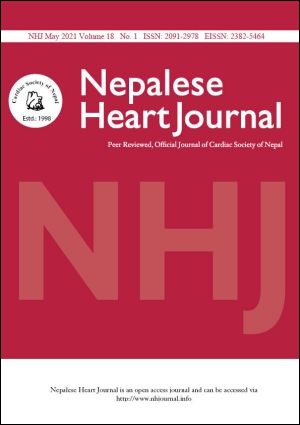A Study of Clinical Profile and Complications In Patients with ST-Elevation Myocardial Infarction Attending In College of Medical Sciences Teaching Hospital, Bharatpur (Chitwan), Nepal.
DOI:
https://doi.org/10.3126/njh.v18i1.36782Keywords:
Acute ST Elevation Myocardial Infarction, Percutaneous Coronary Intervention, ThrombolysisAbstract
Background and Aims: ST-Elevation Myocardial Infarction (STEMI) is a leading cause of morbidity and mortality. This study aims to summarize the clinical profile and complications of patients with STEMI in a teaching hospital.
Methods: This was a prospective hospital based descriptive and observational study conducted at College of Medical Sciences Teaching Hospital (CoMSTH), Bharatpur from January 2017 to July 2018 in 110 patients with a diagnosis of acute STEMI.
Results: Out of 110 patients the mean age of presentation was 59.31 years and 64.5% were male. Typical chest pain (90%) was the most common presenting symptom and 45.5% patients presented within six hours of chest pain. Most common traditional risk factors were hypertension and smoking which were present in 44 (40%) cases, followed by diabetes in 33 (30%), dyslipidemia in 22 (20%). Majority of patients (49.1%) were in killips class I, and only 9 (8.2%) patients were in cardiogenic shock (killips class IV). Inferior wall was the most common in 30% patients followed by anteroseptal wall MI (23.6%), anterior wall MI (11.8%) and combined (anterior and inferior) in 10%. Revascularization with primary Percutaneous Coronary Intervention (PCI) was done in 46 (41.8%) patients, thrombolysis was done in 41 (37.3%) patients. Arrhythmias (39.1%) followed by heart failure (24.5%) were the common complications. The overall in-hospital mortality was 16 (14.5%).
Conclusions: Patients with acute STEMI at College of Medical Sciences Teaching Hospital (CoMSTH) were predominantly male with hypertension and smoking as the commonest risk factors. Arrhythmias were the most common complications and in-hospital mortality rate was 14.5%.
Downloads
Downloads
Published
How to Cite
Issue
Section
License
This license enables reusers to distribute, remix, adapt, and build upon the material in any medium or format, so long as attribution is given to the creator. The license allows for commercial use.




